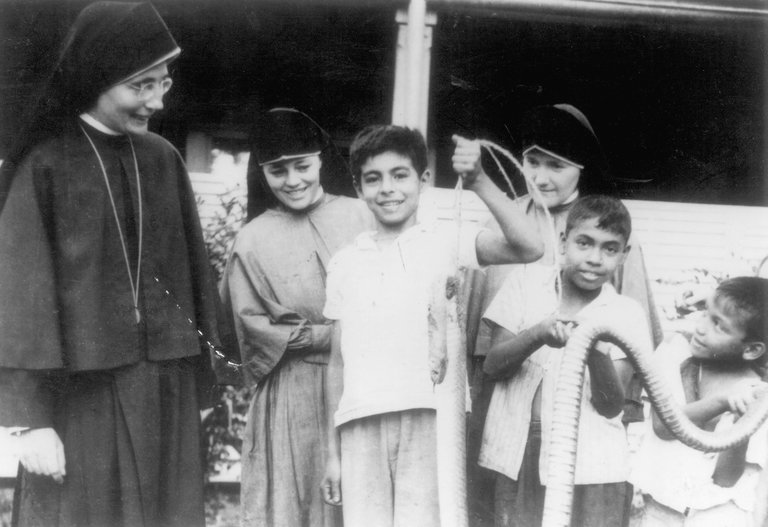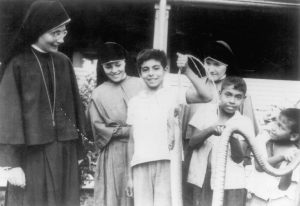At the end of 2016, the New York Times Book Review published a review of A Radical Faith: The Assassination of Sister Maura. This book gives an account of the life and death of Maura Clarke who was born and raised in the Bronx became a Maryknoll nun, was deployed to El Salvador and was murdered along with 2 other nuns and a lay missionary (two of them being raped as well) by a government death squad. She was part of the concerted effort by the Catholic church of El Salvador to aid and protect the peasants and urban poor being persecuted by the Somoza regime, knowing full well that their activities would make them enemies of the state and that their lives would be at stake. So this reveals the strength and resolve that faith can generate, not necessarily faith in this particular credo, but not excluding it (Crowley would hold that belief in the absolute reality of the lineaments of any religion is tantamount to idolatry – that all figures of the Divine are merely hieroglyphs that aid limited human consciousness in approaching Deity); some might consider that this degree of strength and resolve might be an indication of an individual that has discovered and is following their True Will (“Do that, and no other shall say nay.” says Our Lady Nuit in Liber AL I:43)
The book also shows the strange paths that an age-0ld human-run institution can take over millenia. The Roman church, being adopted as the state religion of the Eastern Roman Empire in the 4th Century e.v. would become ensorcelled by temporal/political power for more than a millenium and notorious for its persecution of religious dissenters — despite having been persecuted itself in its early centuries by Roman authorities. And then:
” The old-fashioned church that Maura entered, that preached obedience and submission, changed after the 1962-65 Second Vatican Council and the Medellín bishops’ conference of 1968, opening the door to a fiery theology of liberation. The nuns now felt compelled to denounce “the hierarchies that condemned so many people . . . to poverty” and demand that the church itself, conservative and male-dominated, examine its own role in the unequal distribution of wealth and power. For many who served in religious orders — and Maura is a shining example — this new understanding of the Gospel meant siding with revolution against dictatorship, even at the risk of sharing the fate of a God of the poor who had died on the cross. And, in the case of Maura and many of her religious co-workers, it also meant realizing that her country, the United States, was aiding and abetting the very tyrannies that kept el pueblo de Dios in bondage. Her critique of American foreign policy and Cold War complicity in war crimes is made all the more striking when one considers that the officer who led the death squad that executed her and another who gave the orders had been trained at the School of the Americas, an institution run by the United States that continues to this day to “educate” the military of Latin America despite persistent calls to shut it down…
“The story…picks up once Maura arrives in Nicaragua in 1959 and gets involved with the needs and hopes of her parishioners. It then accelerates even more dramatically once the community she had come to worship as the living embodiment of Jesus joined the Sandinista insurgency destined to topple the corrupt and tyrannical Somoza regime. The final chapters chart Maura’s experience in El Salvador after she answered, not without some trepidation, the call by Archbishop Romero (himself assassinated during Mass a few months before her own death) for Maryknoll sisters to assist the church at a moment when its children, the peasants and squatters of his country, were being persecuted in ways reminiscent of early Christians under the Roman Empire.
“Her final months of activism — ferrying refugees out of conflict zones, offering sanctuary to survivors of massacres, transporting food and medical supplies to faraway and wounded communities, documenting atrocities in case prosecution might someday be viable…
“Maura and her colleagues chose to ignore the death threats they began to receive, insisting that the Good Shepherd does not abandon the flock to the wolves.”
Read the whole article here, if it be thy will: https://www.nytimes.com/2016/12/23/books/review/radical-faith-eileen-markey.html
Of course the Lord Hadit says in Liber AL II:21:
“We have nothing with the outcast and the unfit: let them die in their misery. For they feel not. Compassion is the vice of kings: stamp down the wretched & the weak: this is the law of the strong: this is our law and the joy of the world. Think not, o king, upon that lie: That Thou Must Die: verily thou shalt not die, but live. Now let it be understood: If the body of the King dissolve, he shall remain in pure ecstasy for ever. Nuit! Hadit! Ra-Hoor-Khuit! The Sun, Strength & Sight, Light; these are for the servants of the Star & the Snake.”
So I guess that makes Sister Maura a King. Perhaps one that discovered her True Will. Mebbe.


